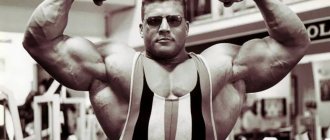Who is stronger - a weightlifter or a boxer? Will a pumped up bodybuilder with a mountain of muscles defeat a light and thin karateka? These questions are more suitable for boyish arguments in the yard, however, serious adult men are also concerned about what is the decisive factor - muscles or skill. If we talk about those who swing in the gyms, they look impressive. As a deterrent, muscle mass will show itself well in street skirmishes - just by preventing them from starting. But will impressive muscles be useful in professional boxing, judo or MMA?
Strength versus mass
All kinds of training are important, different skills are needed. An athlete who completely ignores one or another component will most likely lose to one who is developing comprehensively. However, some significant points can be highlighted.
One of the basic indicators in bodybuilding is gaining muscle mass. It is he who becomes the desired goal of a newcomer who comes to the gym. Big muscles are a sign of a developed athlete. You can’t show good results with a lot of weight without them. The greater your own mass, the more you can take.
In martial arts, the concept of mass is secondary; such an indicator as strength comes to the fore: impact, grip, throw.
Of course, in boxing there are weight categories for athletes, but they were invented in order to equalize the chances of opponents. Therefore, the most ambiguous situation is with the highest limits: the competition between a boxer weighing 92 and 130 kg will no longer be so equal, since the upper limit is not limited by anything.
It is known that the larger the muscle, the more energy it consumes. A person with very large muscles will quickly develop fatigue, while endurance is a key parameter in all martial arts. Therefore, many wrestlers consider training on the formation of large muscles unnecessary. But strength is something that you can’t do without either in striking boxing or in a suffocating “mixed fight”. But when training strength, you may not show good results in weight gain.
Cardio masturbation, or martial arts as an alternative to fitness
What about the martial arts hall? After all, this is an excellent cardio exercise, and even with an “applied component”! Why doesn’t this option often occur to adults? We believe that it’s all about existing stereotypes and misconceptions.
Stereotypical ideas about martial arts
- Martial arts are for children and teenagers . After 25, not to mention the next ominous milestones of 35 and 45 years, seriously fiddling around on the mat or jumping around the ring is somehow already strange and absurd. Should a grown man go to “karate”? Sounds like a curvaceous mother of three should sign up for rhythmic gymnastics!
- Martial arts are for performing athletes . Ordinary “office exercisers” have nothing to do there. When a newcomer appears in the gym, stern professional fighters will snort contemptuously, and their trainers will raise their eyebrows in bewilderment. Or they will chase you away with a humiliating whistle on their well-deserved coaching whistles.
- Martial arts are not for the educated, intelligent public . People with a broad outlook, creative thinking and outstanding mental abilities should not pretend to be Van Dammes and Jackie Chans. The only people who punch each other’s faces and break their backs during training are the “broken” fighters, aggressive proletarians from the outskirts and half-mad patriotic militarists who dream, if not of building a new empire, then at least of reviving the school lessons of the NVP.
- Martial arts are scary and painful . You have never fought before, so you are sure to “take it to the hilt” from some local ruthless champion in the very first sparring on the very first day. He will break your neck, knock off your legs and break your fingers.
- Martial arts mean permanent bruises on the face . Even if you stoically endure “invisible” spinal injuries, your face will still let you down. Cut eyebrows, bruises under the mirrors of the soul, a swollen nose, broken lips and (for sure!) knocked out teeth will reveal the entire unsightly essence of your base activities.
And this will not fail to affect relationships with colleagues, management, clients and partners. Of course, no one will want to deal with you and you will have to part with a decent job.
Source - personal archive of one of the heroes of the “Combat Nerds” channel Andrei Basynin
In reality, things are not quite like that.
Perhaps martial arts were once a marginal hobby for daring characters with athletic faces. But today they have become a useful and safe form of physical activity for normal people of any age.
What actually awaits you in decent martial arts gyms
- Special groups for adult beginners , where patient trainers will try to hew out of flimsy or loose (but equally “wooden”) enthusiasts something relatively combat-ready. Yes, children grasp everything much faster, but they also study separately. So don’t be afraid to become an object of ridicule for your child’s classmates—they won’t see your “deadly kung fu.”
- Lack of competitive ambitions in most of your training colleagues. The same “nerds” will train next to you, far from even thinking about fighting tournaments. And if after a year or two you still want to test what you have learned, then amateur “open rings” or “open mats” are at your service. But in any case, no one will force you to fight for medals and certificates. Moreover, many types of martial arts do not involve competition at all.
- Meet interesting people from different professions. Even if you don't earn your living through brutal physical labor, you won't be subject to class hatred in the locker room of a martial arts gym. Here you will meet a fashionable DJ and university associate professor, a dentist and front-end developer, an editor of a popular online media and an oriental philologist. There are few female students. There are generally an order of magnitude fewer girls than in fitness clubs. This is a minus. But if you are a girl, then you will get all the male attention. That's a plus.
- No contact sparring for beginners! Don’t worry, you won’t be given over to be torn to pieces by a seasoned fighter. The first months will be devoted to learning basic techniques and gradually improving physical condition. And only then will careful work in pairs begin - with students of your same level and under the careful supervision of the coach.
- Protective equipment . A helmet and mouthguard will prevent you from looking like a drunkard bully or an unfortunate victim of domestic violence. Not to mention the fact that there are a sufficient number of styles and schools of martial arts where they do not practice blows to the head at all. But for other important parts of the body, special protection is also provided, which, however, will have to fork out for. But choosing equipment is a separate pleasure, where even gloomy phlegmatic people turn into passionate fashionistas and shopaholics.
Source - episode of the “Combat Nerds” channel
Now that you have calmed down a little, let’s talk about those nuances of martial arts that will be somewhat unusual for the inhabitants of fitness clubs. Unusual, but mostly favorable.
What is the difference between training in martial arts and training in the gym?
- More intense and varied workouts . Here you won’t be able to read Twitter between sets and take a leisurely stroll to the cooler. But you won’t be bored: the “range” of tasks and exercises is practically inexhaustible.
- Group classes . Collective training, a lot of work in pairs - all this is not at all similar to the individualism of the gym. However, even if you are a beech, a misanthrope and an introvert, don’t be upset: you don’t have to talk to your partners. But the notorious “feeling of comradeship” and “spirit of camaraderie” will slowly germinate in your gloomy soul.
- Scheduled workouts . Free access to a fitness club often plays a cruel joke on weak-willed membership holders. “Today I’m feeling lazy”, “It’s late, I’ll go better tomorrow”, “Difficulties at work, I’ll go to the gym next week” - all these traps are very familiar to you. It’s not like that with martial arts: the day and time of the class are known, the coach is waiting, all the guys are there—psychologically it’s harder to miss a workout.
- Work under the guidance of a trainer . If in the gym you are most often left to your own devices (unless you buy personal training, of course), then in martial arts you are always trained by a qualified specialist. The right coach will keep an eye on the entire group, will not allow you to injure yourself and your partner, will correct mistakes and thereby provide all the conditions for progress. If the group is large, older students help. And yes, you can also take personal lessons in martial arts.
- Martial arts are more expensive than rocking.
 We must recognize this shortcoming, which is especially significant in times of crisis. On average, group martial arts training (three times a week) will cost you 2–3 times more than an unlimited visit to a middle-class fitness club. You can take comfort in the mantra “more expensive is better,” and also in the fact that in the case of martial arts you are investing not only in your own health, but also, to some extent, in your safety.
We must recognize this shortcoming, which is especially significant in times of crisis. On average, group martial arts training (three times a week) will cost you 2–3 times more than an unlimited visit to a middle-class fitness club. You can take comfort in the mantra “more expensive is better,” and also in the fact that in the case of martial arts you are investing not only in your own health, but also, to some extent, in your safety.
And if we're talking about costs and investments, let's briefly list what to expect at the end.
What goals can be achieved by doing martial arts?
- Lose weight.
- Improve coordination of movements.
- Become faster, stronger and more resilient.
- Gain self-defense skills and learn how to take a blow in every sense.
- Gain flexibility and stretching (although splits are not necessary for kicking).
In all martial arts clubs, martial arts halls, applied self-defense sections, will you not have to regret the money and time spent? Will you enjoy the process and achieve the desired results? Alas, no, disappointments are possible.
How to choose the right type of martial arts and a competent trainer
A very relevant question. After all, if you make a mistake in choosing your type of martial arts, and mistake a charlatan for a great coach, then you may well suffer some damage. Financial, physical and moral. We will tell you how to do everything correctly, what to pay attention to and where the catch may lie in the next article.
Good luck! Read Lifehacker and watch the fun and useful YouTube channel about martial arts “Combat Nerds”!
Beauty versus performance
An important component of bodybuilding is also the beauty of the existing muscles, the “sculpting” of the body. This is why they resort to intensive drying before competitions - so that not a single gram of fat covers the splendor of developed muscles.
The fighters do not have such a task. We can see athletes in the ring who are slightly fat, and sometimes with a little belly. Moreover, truly strong muscles are not always beautiful. For example, you can take Alexander Karelin, who has already completed his career. He won Greco-Roman wrestling matches thanks to his enormous strength. However, there is no smell of bodybuilding aesthetics there. This is why many truly strong wrestlers do not look pumped up, otherwise they will lose in endurance in the fight "on the ground floor".
Attitude to large muscles in different types of martial arts
In various types of wrestling, large muscles are evaluated differently. The common thing is that everywhere they will serve maximum auxiliary purposes, the attitude can be from favorable to very cool.
Martial arts
Karate, judo, wushu, kung fu - all these types have one thing in common: the “subtlety” of fighters from the point of view of a bodybuilder. Almost no one here has big muscles. This is explained by many factors: both the philosophy of combat and its features.
For example, in striking systems like karate there is a lot of jumping kicking. This is where the weight of the muscles becomes a hindrance. In addition, the culture of the East, where most of these sports come from, completely ignored the phenomenon of bodybuilding for a long time.
MMA
This type of martial arts has become popular in the world relatively recently. In addition to striking techniques with legs and arms, it uses various grips, painful and choking techniques. Mixed martial arts fighters have athletic builds, many lift weights, but avoid developing large muscles.
Strength training predominates, including static training. Tendon strength is more important than biceps circumference. The energy consumption required for pumped up muscles may not allow the athlete to bring the fight to victory.
Boxing
Boxers are the closest to “jocks” among other representatives of martial arts. Many of them work out with weights, perform barbell presses and use exercise machines. The athlete and his coach themselves choose the regime of combining training with weights and boxing.
Many boxers showed a good bench press, and in different weights - here are Mike, Tyson, and Kostya Tszyu, and many others. However, an athlete should always remember that while increasing mass, he loses speed and endurance. If we recall the famous Mohammed Ali, it was precisely balancing on the very edge of heavy weight that allowed him to implement the well-known formula: “Float like a butterfly, sting like a bee.”
All this time we were talking about professionals. By playing sports for yourself, you can usefully combine bodybuilding and martial arts, which will make the athlete more versatile and strong.
Rules for combining strength training and martial arts
- Remember, you can’t do 2 workouts a day, i.e. after the gym, run to the boxing gym or vice versa, remember 1 workout – 1 day. If you still combine, it means you are not giving your all and the training is idling.
- If you visit the gym, do not lift during martial arts training, for example - do not use parallel bars, pull-ups, bench press and other set of standard training exercises, because you do all this in the gym.
- If the training goes on consecutively, that is, day after day, then train first in the gym, and then in the boxing room, the fact is that training in martial arts is very exhausting and you are unlikely to be able to give your best in the training room the next day, you will be overcome by fatigue.
- Be sure to remove all isolated exercises in the gym, leaving only the basic ones in your arsenal. It is these exercises that give a boost to strength and mass. The workout should be no more than 1 hour, and the rest between exercises should be 2-3 minutes.
- When combining strength training and martial arts, you can easily overtrain and recovery can take a long time, so if you feel constantly tired, reduce your training time.











